Consumer Behaviour Report: Promoting Solar Panel Adoption - MKG210
VerifiedAdded on 2023/06/11
|10
|2460
|277
Report
AI Summary
This report examines the consumer behavior influencing the purchase of solar panels and home batteries by Australian households, who are facing challenges due to increasing energy bills. It reviews existing literature on consumer adoption of such technologies, highlighting factors like marketing campaigns, economic conditions, personal preferences, and group influence. The report suggests marketing strategies, including market opportunity analysis, target market selection (specifically the 50-72 age group), and marketing mix decisions (product, price, place, and promotion), to encourage adoption. It concludes by recommending the development of a comprehensive marketing mix strategy and advertising to demonstrate the usefulness of solar panels, ultimately shaping consumer purchasing decisions and promoting sustainable energy solutions. Desklib provides access to similar solved assignments and past papers for students.
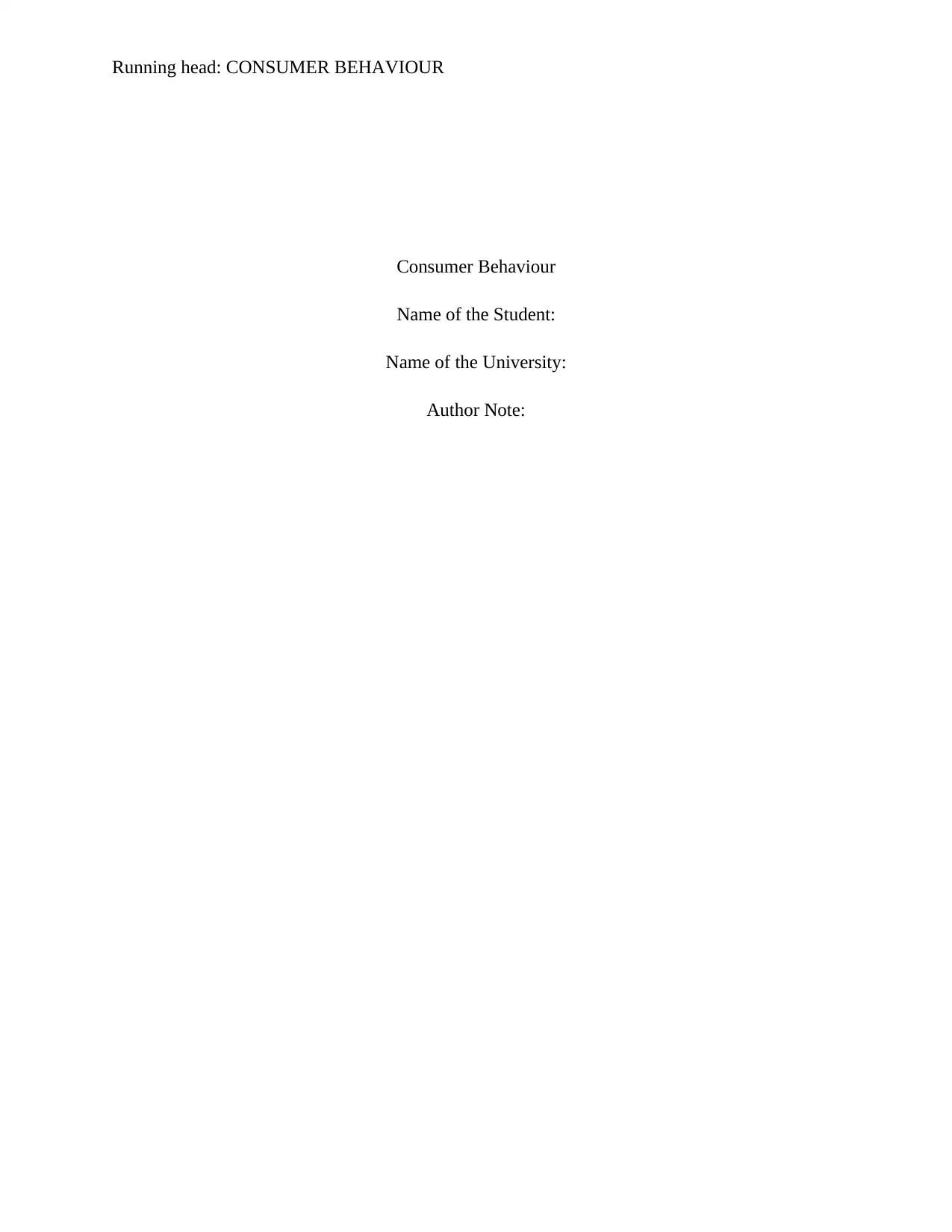
Running head: CONSUMER BEHAVIOUR
Consumer Behaviour
Name of the Student:
Name of the University:
Author Note:
Consumer Behaviour
Name of the Student:
Name of the University:
Author Note:
Paraphrase This Document
Need a fresh take? Get an instant paraphrase of this document with our AI Paraphraser
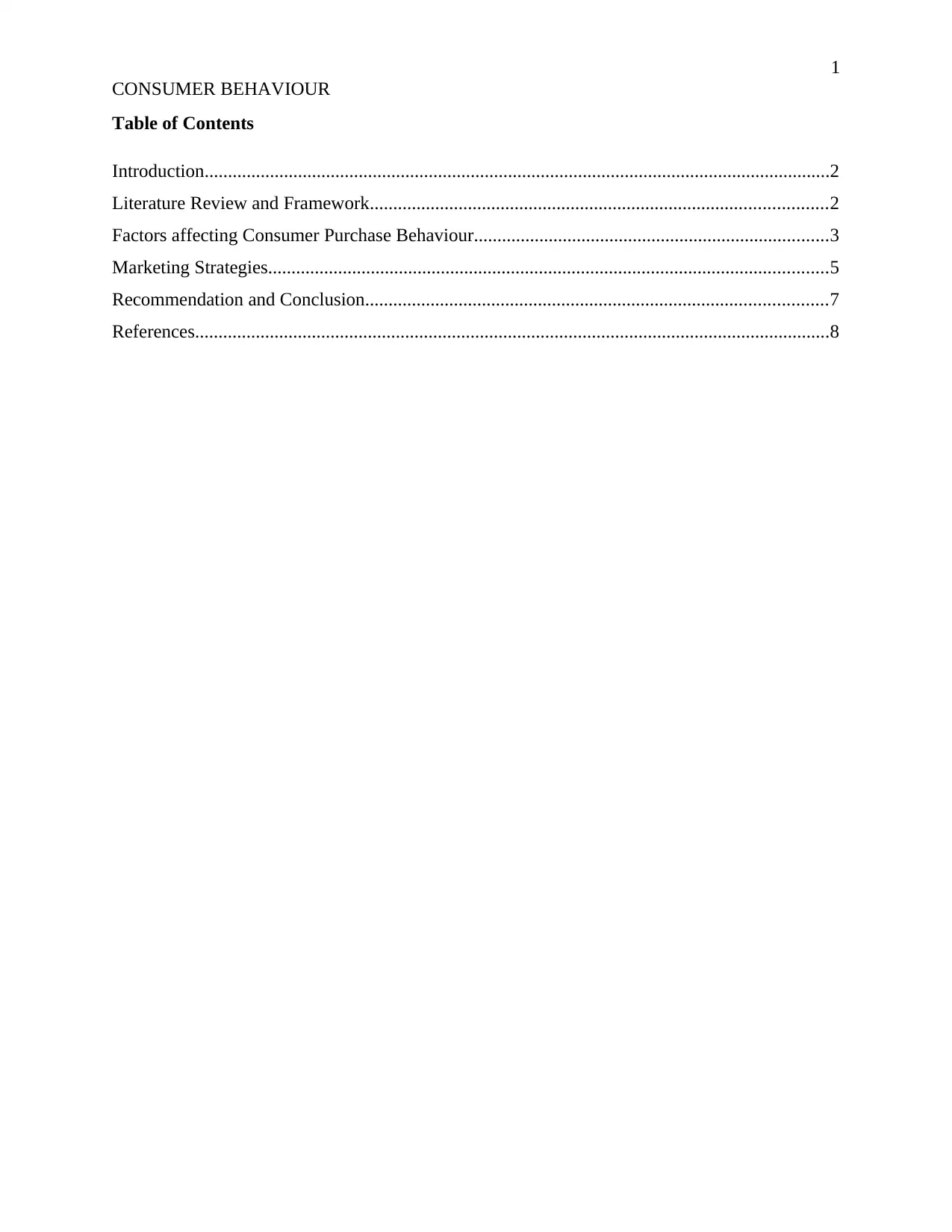
1
CONSUMER BEHAVIOUR
Table of Contents
Introduction......................................................................................................................................2
Literature Review and Framework..................................................................................................2
Factors affecting Consumer Purchase Behaviour............................................................................3
Marketing Strategies........................................................................................................................5
Recommendation and Conclusion...................................................................................................7
References........................................................................................................................................8
CONSUMER BEHAVIOUR
Table of Contents
Introduction......................................................................................................................................2
Literature Review and Framework..................................................................................................2
Factors affecting Consumer Purchase Behaviour............................................................................3
Marketing Strategies........................................................................................................................5
Recommendation and Conclusion...................................................................................................7
References........................................................................................................................................8
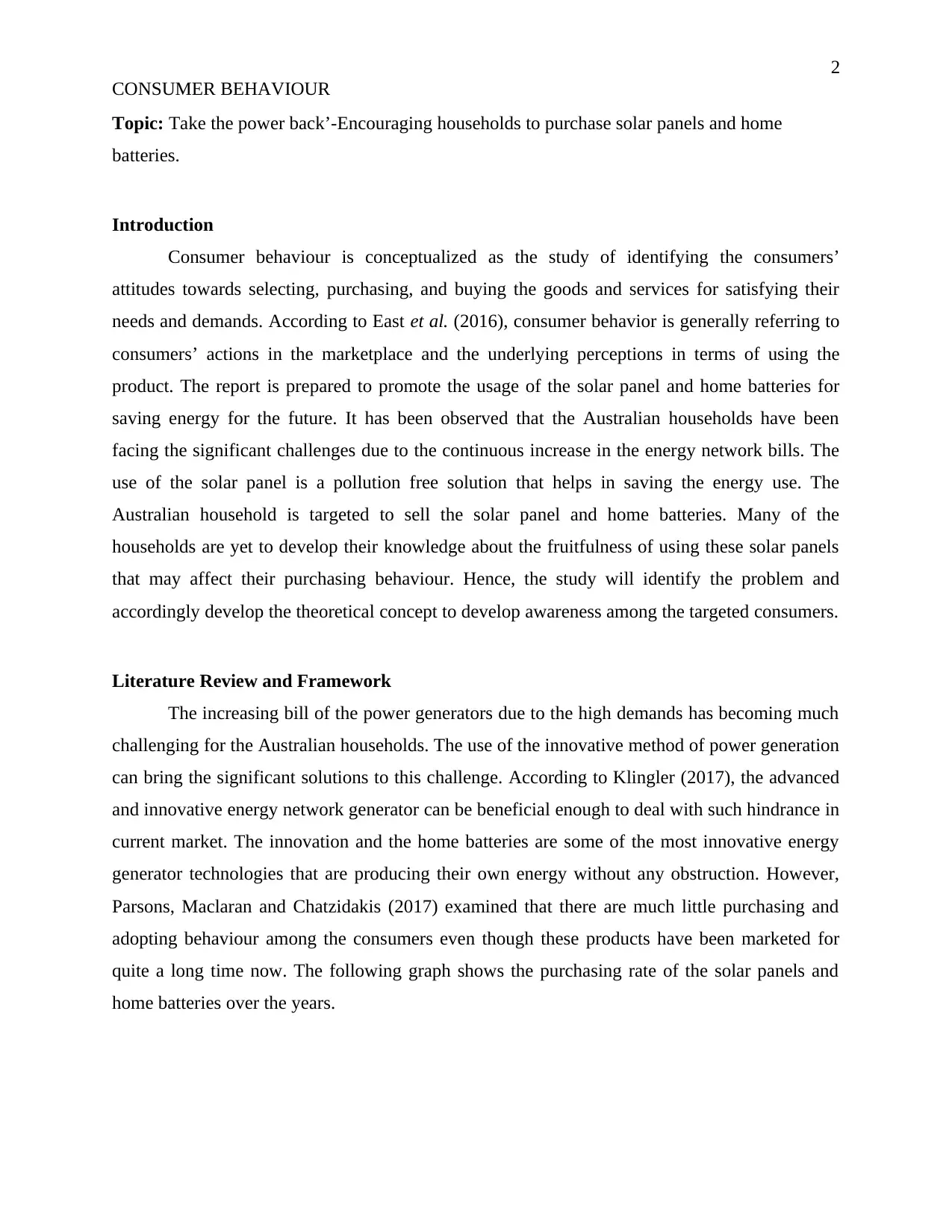
2
CONSUMER BEHAVIOUR
Topic: Take the power back’-Encouraging households to purchase solar panels and home
batteries.
Introduction
Consumer behaviour is conceptualized as the study of identifying the consumers’
attitudes towards selecting, purchasing, and buying the goods and services for satisfying their
needs and demands. According to East et al. (2016), consumer behavior is generally referring to
consumers’ actions in the marketplace and the underlying perceptions in terms of using the
product. The report is prepared to promote the usage of the solar panel and home batteries for
saving energy for the future. It has been observed that the Australian households have been
facing the significant challenges due to the continuous increase in the energy network bills. The
use of the solar panel is a pollution free solution that helps in saving the energy use. The
Australian household is targeted to sell the solar panel and home batteries. Many of the
households are yet to develop their knowledge about the fruitfulness of using these solar panels
that may affect their purchasing behaviour. Hence, the study will identify the problem and
accordingly develop the theoretical concept to develop awareness among the targeted consumers.
Literature Review and Framework
The increasing bill of the power generators due to the high demands has becoming much
challenging for the Australian households. The use of the innovative method of power generation
can bring the significant solutions to this challenge. According to Klingler (2017), the advanced
and innovative energy network generator can be beneficial enough to deal with such hindrance in
current market. The innovation and the home batteries are some of the most innovative energy
generator technologies that are producing their own energy without any obstruction. However,
Parsons, Maclaran and Chatzidakis (2017) examined that there are much little purchasing and
adopting behaviour among the consumers even though these products have been marketed for
quite a long time now. The following graph shows the purchasing rate of the solar panels and
home batteries over the years.
CONSUMER BEHAVIOUR
Topic: Take the power back’-Encouraging households to purchase solar panels and home
batteries.
Introduction
Consumer behaviour is conceptualized as the study of identifying the consumers’
attitudes towards selecting, purchasing, and buying the goods and services for satisfying their
needs and demands. According to East et al. (2016), consumer behavior is generally referring to
consumers’ actions in the marketplace and the underlying perceptions in terms of using the
product. The report is prepared to promote the usage of the solar panel and home batteries for
saving energy for the future. It has been observed that the Australian households have been
facing the significant challenges due to the continuous increase in the energy network bills. The
use of the solar panel is a pollution free solution that helps in saving the energy use. The
Australian household is targeted to sell the solar panel and home batteries. Many of the
households are yet to develop their knowledge about the fruitfulness of using these solar panels
that may affect their purchasing behaviour. Hence, the study will identify the problem and
accordingly develop the theoretical concept to develop awareness among the targeted consumers.
Literature Review and Framework
The increasing bill of the power generators due to the high demands has becoming much
challenging for the Australian households. The use of the innovative method of power generation
can bring the significant solutions to this challenge. According to Klingler (2017), the advanced
and innovative energy network generator can be beneficial enough to deal with such hindrance in
current market. The innovation and the home batteries are some of the most innovative energy
generator technologies that are producing their own energy without any obstruction. However,
Parsons, Maclaran and Chatzidakis (2017) examined that there are much little purchasing and
adopting behaviour among the consumers even though these products have been marketed for
quite a long time now. The following graph shows the purchasing rate of the solar panels and
home batteries over the years.
⊘ This is a preview!⊘
Do you want full access?
Subscribe today to unlock all pages.

Trusted by 1+ million students worldwide
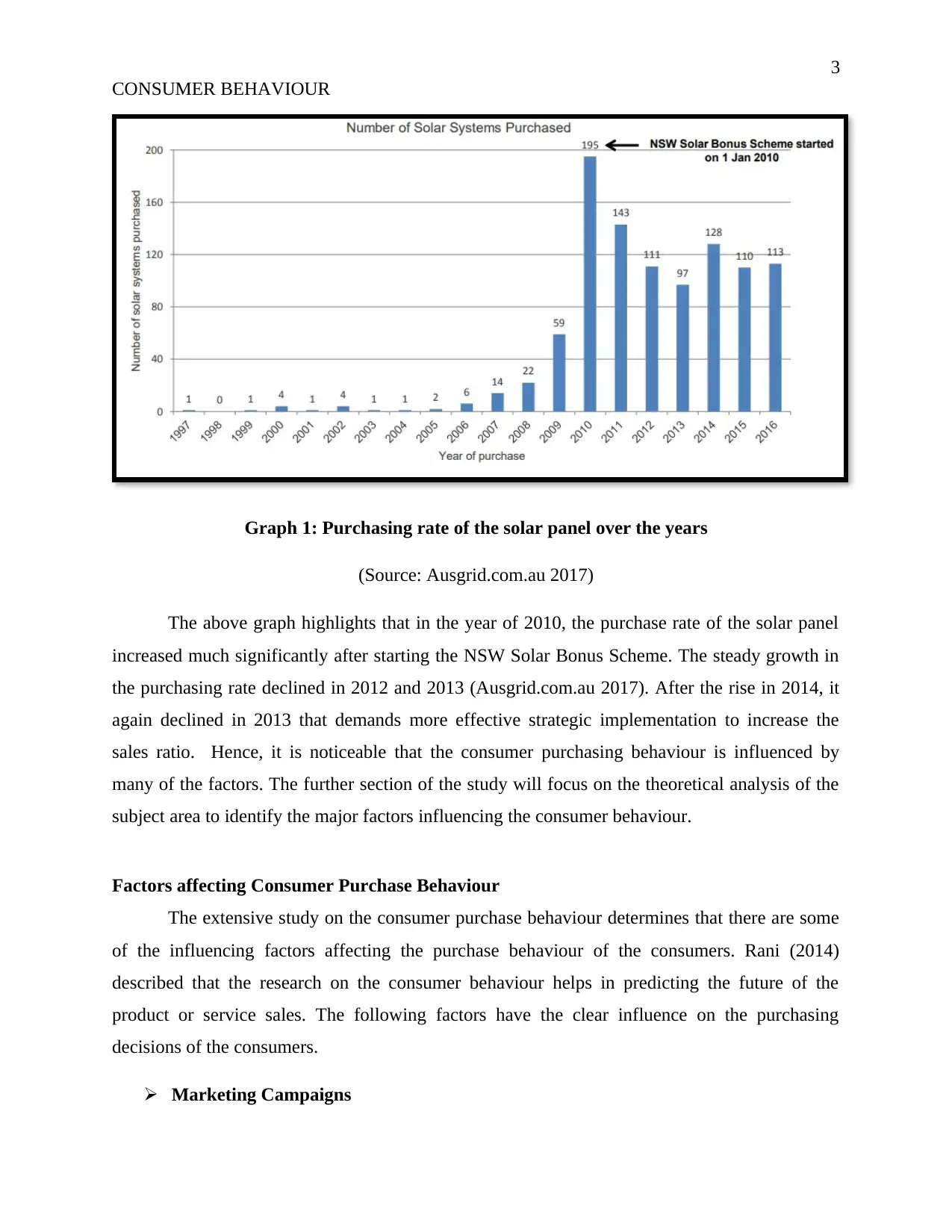
3
CONSUMER BEHAVIOUR
Graph 1: Purchasing rate of the solar panel over the years
(Source: Ausgrid.com.au 2017)
The above graph highlights that in the year of 2010, the purchase rate of the solar panel
increased much significantly after starting the NSW Solar Bonus Scheme. The steady growth in
the purchasing rate declined in 2012 and 2013 (Ausgrid.com.au 2017). After the rise in 2014, it
again declined in 2013 that demands more effective strategic implementation to increase the
sales ratio. Hence, it is noticeable that the consumer purchasing behaviour is influenced by
many of the factors. The further section of the study will focus on the theoretical analysis of the
subject area to identify the major factors influencing the consumer behaviour.
Factors affecting Consumer Purchase Behaviour
The extensive study on the consumer purchase behaviour determines that there are some
of the influencing factors affecting the purchase behaviour of the consumers. Rani (2014)
described that the research on the consumer behaviour helps in predicting the future of the
product or service sales. The following factors have the clear influence on the purchasing
decisions of the consumers.
Marketing Campaigns
CONSUMER BEHAVIOUR
Graph 1: Purchasing rate of the solar panel over the years
(Source: Ausgrid.com.au 2017)
The above graph highlights that in the year of 2010, the purchase rate of the solar panel
increased much significantly after starting the NSW Solar Bonus Scheme. The steady growth in
the purchasing rate declined in 2012 and 2013 (Ausgrid.com.au 2017). After the rise in 2014, it
again declined in 2013 that demands more effective strategic implementation to increase the
sales ratio. Hence, it is noticeable that the consumer purchasing behaviour is influenced by
many of the factors. The further section of the study will focus on the theoretical analysis of the
subject area to identify the major factors influencing the consumer behaviour.
Factors affecting Consumer Purchase Behaviour
The extensive study on the consumer purchase behaviour determines that there are some
of the influencing factors affecting the purchase behaviour of the consumers. Rani (2014)
described that the research on the consumer behaviour helps in predicting the future of the
product or service sales. The following factors have the clear influence on the purchasing
decisions of the consumers.
Marketing Campaigns
Paraphrase This Document
Need a fresh take? Get an instant paraphrase of this document with our AI Paraphraser
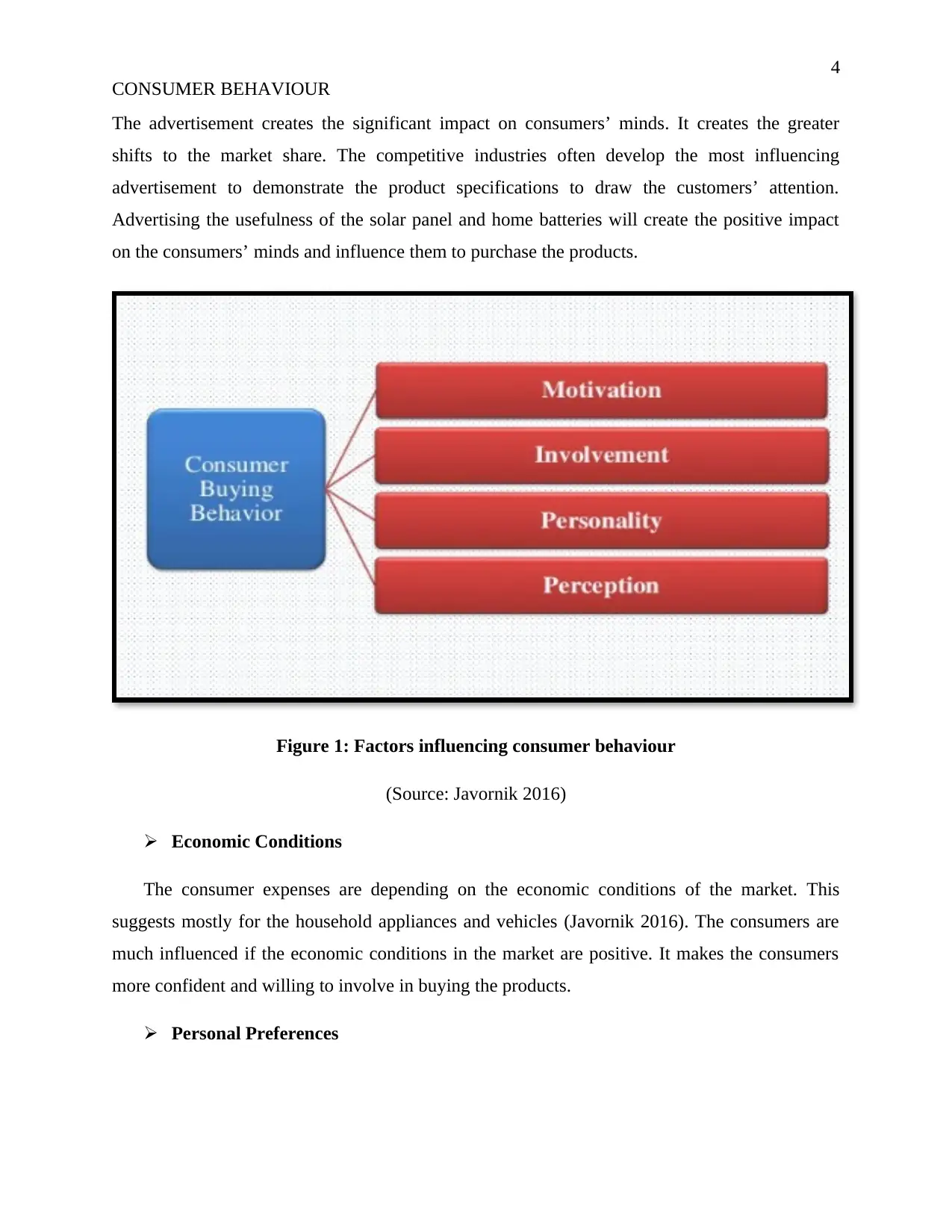
4
CONSUMER BEHAVIOUR
The advertisement creates the significant impact on consumers’ minds. It creates the greater
shifts to the market share. The competitive industries often develop the most influencing
advertisement to demonstrate the product specifications to draw the customers’ attention.
Advertising the usefulness of the solar panel and home batteries will create the positive impact
on the consumers’ minds and influence them to purchase the products.
Figure 1: Factors influencing consumer behaviour
(Source: Javornik 2016)
Economic Conditions
The consumer expenses are depending on the economic conditions of the market. This
suggests mostly for the household appliances and vehicles (Javornik 2016). The consumers are
much influenced if the economic conditions in the market are positive. It makes the consumers
more confident and willing to involve in buying the products.
Personal Preferences
CONSUMER BEHAVIOUR
The advertisement creates the significant impact on consumers’ minds. It creates the greater
shifts to the market share. The competitive industries often develop the most influencing
advertisement to demonstrate the product specifications to draw the customers’ attention.
Advertising the usefulness of the solar panel and home batteries will create the positive impact
on the consumers’ minds and influence them to purchase the products.
Figure 1: Factors influencing consumer behaviour
(Source: Javornik 2016)
Economic Conditions
The consumer expenses are depending on the economic conditions of the market. This
suggests mostly for the household appliances and vehicles (Javornik 2016). The consumers are
much influenced if the economic conditions in the market are positive. It makes the consumers
more confident and willing to involve in buying the products.
Personal Preferences
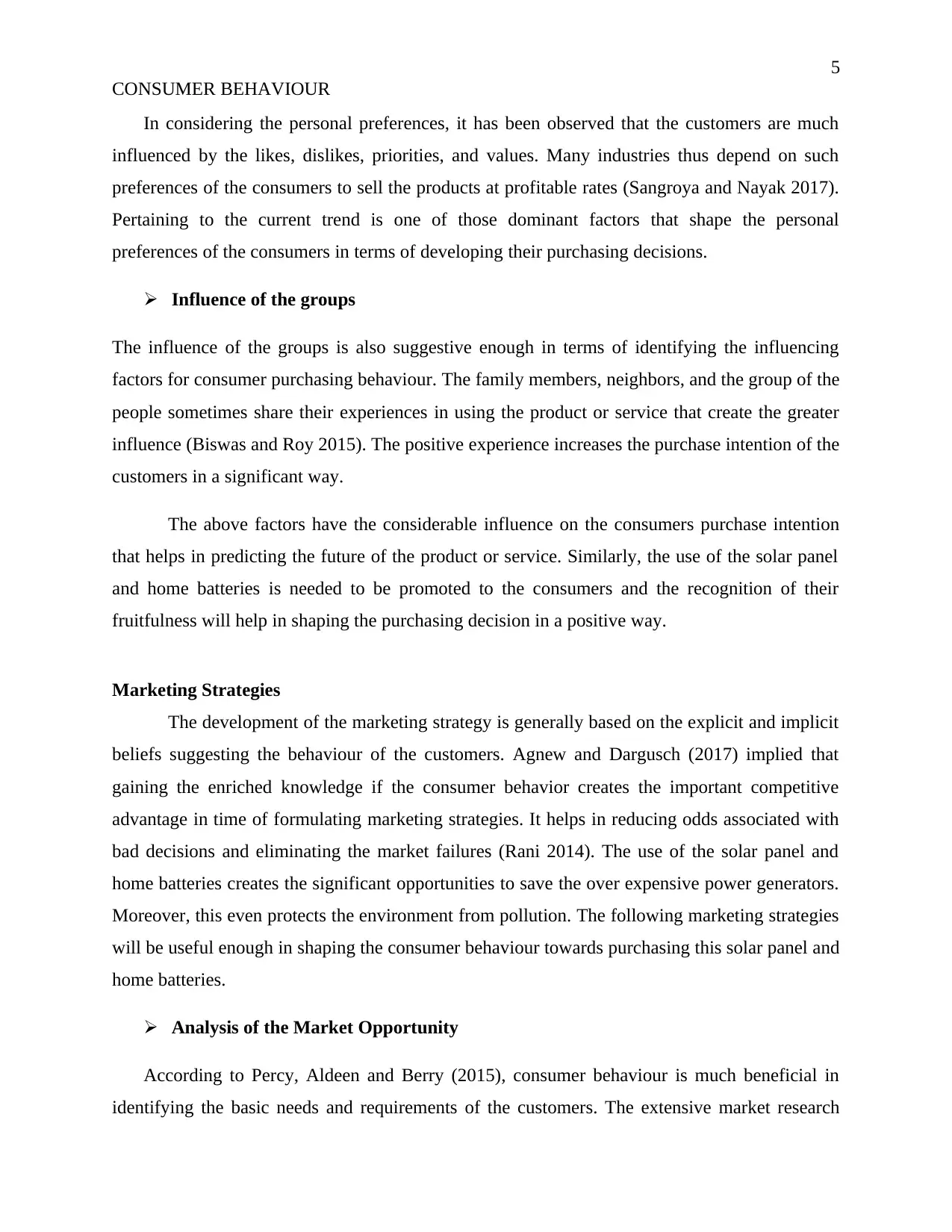
5
CONSUMER BEHAVIOUR
In considering the personal preferences, it has been observed that the customers are much
influenced by the likes, dislikes, priorities, and values. Many industries thus depend on such
preferences of the consumers to sell the products at profitable rates (Sangroya and Nayak 2017).
Pertaining to the current trend is one of those dominant factors that shape the personal
preferences of the consumers in terms of developing their purchasing decisions.
Influence of the groups
The influence of the groups is also suggestive enough in terms of identifying the influencing
factors for consumer purchasing behaviour. The family members, neighbors, and the group of the
people sometimes share their experiences in using the product or service that create the greater
influence (Biswas and Roy 2015). The positive experience increases the purchase intention of the
customers in a significant way.
The above factors have the considerable influence on the consumers purchase intention
that helps in predicting the future of the product or service. Similarly, the use of the solar panel
and home batteries is needed to be promoted to the consumers and the recognition of their
fruitfulness will help in shaping the purchasing decision in a positive way.
Marketing Strategies
The development of the marketing strategy is generally based on the explicit and implicit
beliefs suggesting the behaviour of the customers. Agnew and Dargusch (2017) implied that
gaining the enriched knowledge if the consumer behavior creates the important competitive
advantage in time of formulating marketing strategies. It helps in reducing odds associated with
bad decisions and eliminating the market failures (Rani 2014). The use of the solar panel and
home batteries creates the significant opportunities to save the over expensive power generators.
Moreover, this even protects the environment from pollution. The following marketing strategies
will be useful enough in shaping the consumer behaviour towards purchasing this solar panel and
home batteries.
Analysis of the Market Opportunity
According to Percy, Aldeen and Berry (2015), consumer behaviour is much beneficial in
identifying the basic needs and requirements of the customers. The extensive market research
CONSUMER BEHAVIOUR
In considering the personal preferences, it has been observed that the customers are much
influenced by the likes, dislikes, priorities, and values. Many industries thus depend on such
preferences of the consumers to sell the products at profitable rates (Sangroya and Nayak 2017).
Pertaining to the current trend is one of those dominant factors that shape the personal
preferences of the consumers in terms of developing their purchasing decisions.
Influence of the groups
The influence of the groups is also suggestive enough in terms of identifying the influencing
factors for consumer purchasing behaviour. The family members, neighbors, and the group of the
people sometimes share their experiences in using the product or service that create the greater
influence (Biswas and Roy 2015). The positive experience increases the purchase intention of the
customers in a significant way.
The above factors have the considerable influence on the consumers purchase intention
that helps in predicting the future of the product or service. Similarly, the use of the solar panel
and home batteries is needed to be promoted to the consumers and the recognition of their
fruitfulness will help in shaping the purchasing decision in a positive way.
Marketing Strategies
The development of the marketing strategy is generally based on the explicit and implicit
beliefs suggesting the behaviour of the customers. Agnew and Dargusch (2017) implied that
gaining the enriched knowledge if the consumer behavior creates the important competitive
advantage in time of formulating marketing strategies. It helps in reducing odds associated with
bad decisions and eliminating the market failures (Rani 2014). The use of the solar panel and
home batteries creates the significant opportunities to save the over expensive power generators.
Moreover, this even protects the environment from pollution. The following marketing strategies
will be useful enough in shaping the consumer behaviour towards purchasing this solar panel and
home batteries.
Analysis of the Market Opportunity
According to Percy, Aldeen and Berry (2015), consumer behaviour is much beneficial in
identifying the basic needs and requirements of the customers. The extensive market research
⊘ This is a preview!⊘
Do you want full access?
Subscribe today to unlock all pages.

Trusted by 1+ million students worldwide
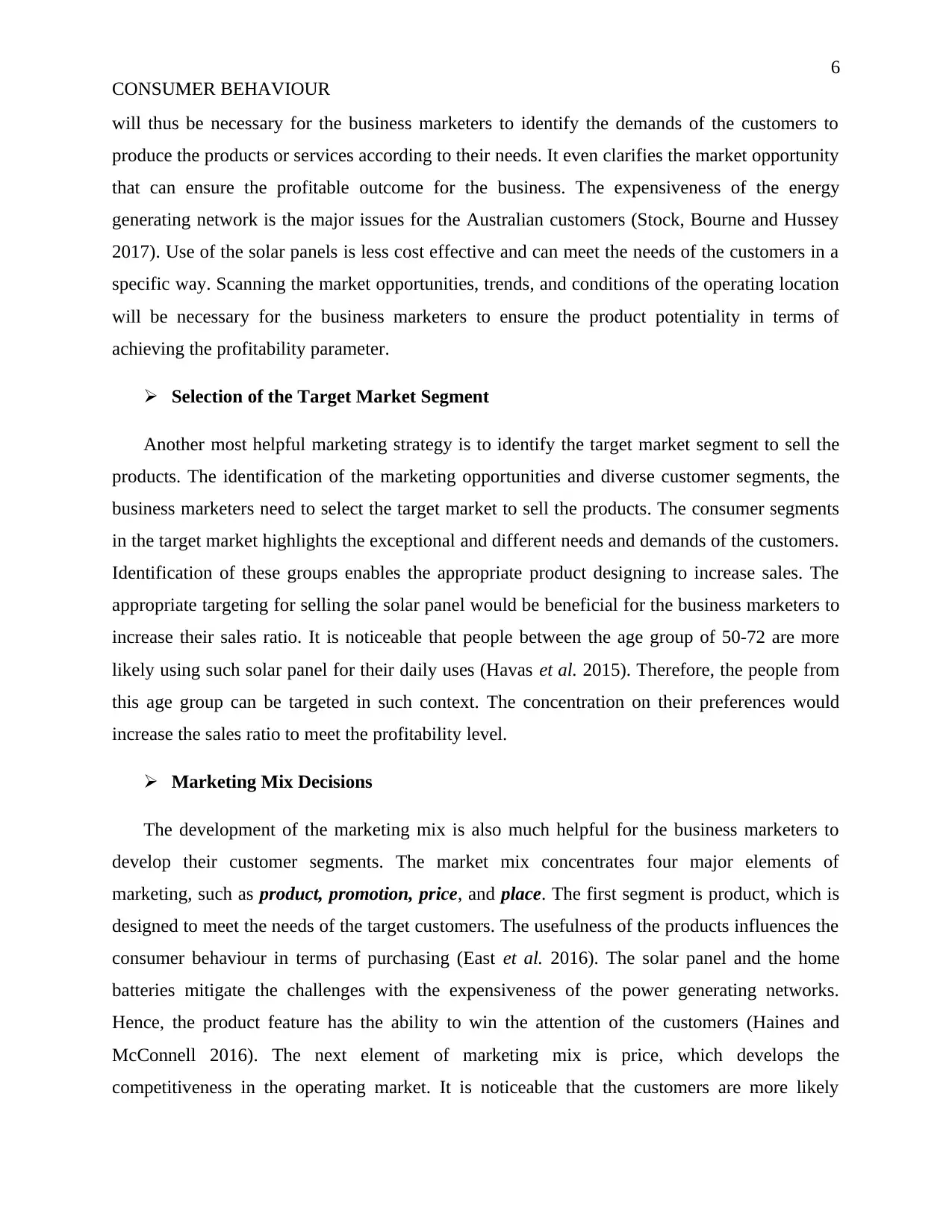
6
CONSUMER BEHAVIOUR
will thus be necessary for the business marketers to identify the demands of the customers to
produce the products or services according to their needs. It even clarifies the market opportunity
that can ensure the profitable outcome for the business. The expensiveness of the energy
generating network is the major issues for the Australian customers (Stock, Bourne and Hussey
2017). Use of the solar panels is less cost effective and can meet the needs of the customers in a
specific way. Scanning the market opportunities, trends, and conditions of the operating location
will be necessary for the business marketers to ensure the product potentiality in terms of
achieving the profitability parameter.
Selection of the Target Market Segment
Another most helpful marketing strategy is to identify the target market segment to sell the
products. The identification of the marketing opportunities and diverse customer segments, the
business marketers need to select the target market to sell the products. The consumer segments
in the target market highlights the exceptional and different needs and demands of the customers.
Identification of these groups enables the appropriate product designing to increase sales. The
appropriate targeting for selling the solar panel would be beneficial for the business marketers to
increase their sales ratio. It is noticeable that people between the age group of 50-72 are more
likely using such solar panel for their daily uses (Havas et al. 2015). Therefore, the people from
this age group can be targeted in such context. The concentration on their preferences would
increase the sales ratio to meet the profitability level.
Marketing Mix Decisions
The development of the marketing mix is also much helpful for the business marketers to
develop their customer segments. The market mix concentrates four major elements of
marketing, such as product, promotion, price, and place. The first segment is product, which is
designed to meet the needs of the target customers. The usefulness of the products influences the
consumer behaviour in terms of purchasing (East et al. 2016). The solar panel and the home
batteries mitigate the challenges with the expensiveness of the power generating networks.
Hence, the product feature has the ability to win the attention of the customers (Haines and
McConnell 2016). The next element of marketing mix is price, which develops the
competitiveness in the operating market. It is noticeable that the customers are more likely
CONSUMER BEHAVIOUR
will thus be necessary for the business marketers to identify the demands of the customers to
produce the products or services according to their needs. It even clarifies the market opportunity
that can ensure the profitable outcome for the business. The expensiveness of the energy
generating network is the major issues for the Australian customers (Stock, Bourne and Hussey
2017). Use of the solar panels is less cost effective and can meet the needs of the customers in a
specific way. Scanning the market opportunities, trends, and conditions of the operating location
will be necessary for the business marketers to ensure the product potentiality in terms of
achieving the profitability parameter.
Selection of the Target Market Segment
Another most helpful marketing strategy is to identify the target market segment to sell the
products. The identification of the marketing opportunities and diverse customer segments, the
business marketers need to select the target market to sell the products. The consumer segments
in the target market highlights the exceptional and different needs and demands of the customers.
Identification of these groups enables the appropriate product designing to increase sales. The
appropriate targeting for selling the solar panel would be beneficial for the business marketers to
increase their sales ratio. It is noticeable that people between the age group of 50-72 are more
likely using such solar panel for their daily uses (Havas et al. 2015). Therefore, the people from
this age group can be targeted in such context. The concentration on their preferences would
increase the sales ratio to meet the profitability level.
Marketing Mix Decisions
The development of the marketing mix is also much helpful for the business marketers to
develop their customer segments. The market mix concentrates four major elements of
marketing, such as product, promotion, price, and place. The first segment is product, which is
designed to meet the needs of the target customers. The usefulness of the products influences the
consumer behaviour in terms of purchasing (East et al. 2016). The solar panel and the home
batteries mitigate the challenges with the expensiveness of the power generating networks.
Hence, the product feature has the ability to win the attention of the customers (Haines and
McConnell 2016). The next element of marketing mix is price, which develops the
competitiveness in the operating market. It is noticeable that the customers are more likely
Paraphrase This Document
Need a fresh take? Get an instant paraphrase of this document with our AI Paraphraser
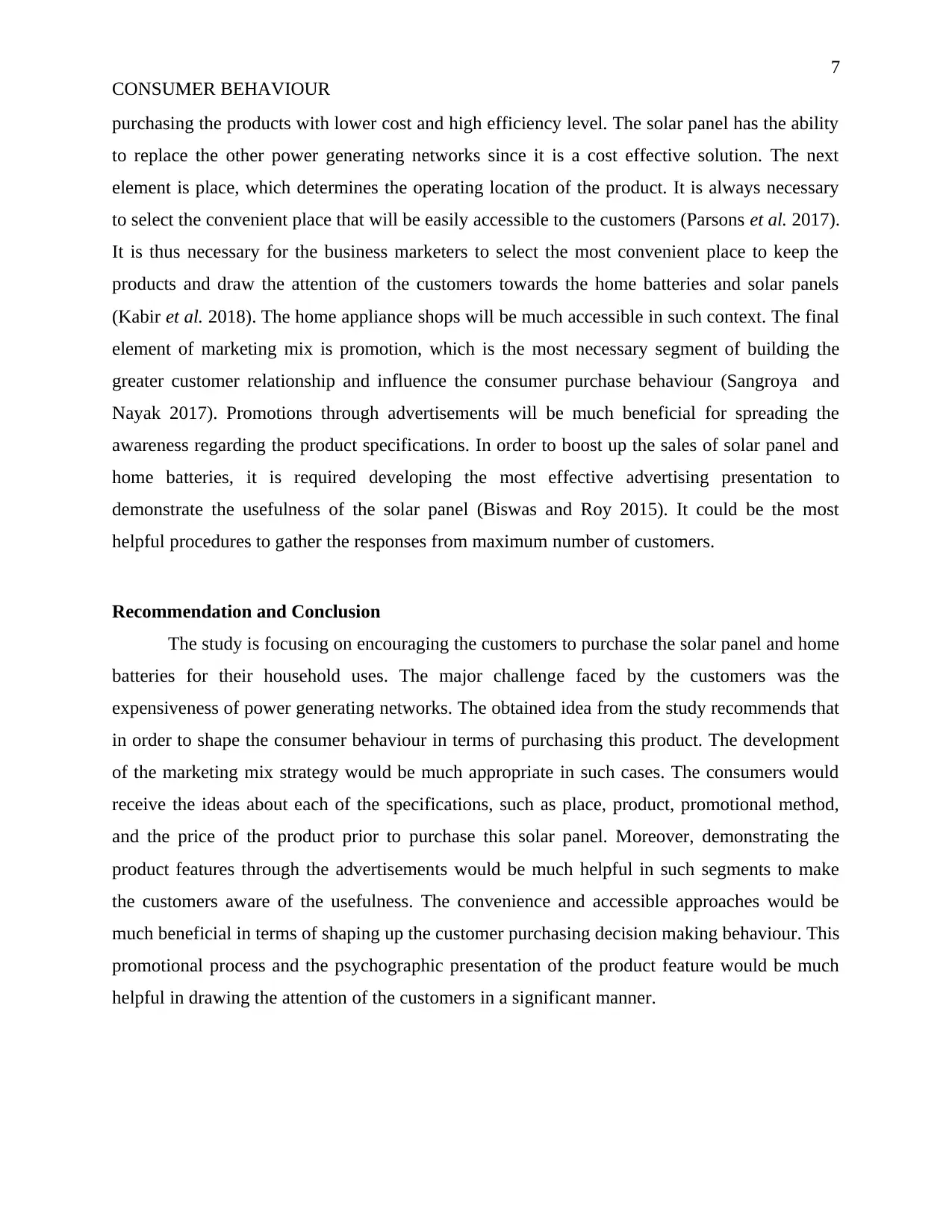
7
CONSUMER BEHAVIOUR
purchasing the products with lower cost and high efficiency level. The solar panel has the ability
to replace the other power generating networks since it is a cost effective solution. The next
element is place, which determines the operating location of the product. It is always necessary
to select the convenient place that will be easily accessible to the customers (Parsons et al. 2017).
It is thus necessary for the business marketers to select the most convenient place to keep the
products and draw the attention of the customers towards the home batteries and solar panels
(Kabir et al. 2018). The home appliance shops will be much accessible in such context. The final
element of marketing mix is promotion, which is the most necessary segment of building the
greater customer relationship and influence the consumer purchase behaviour (Sangroya and
Nayak 2017). Promotions through advertisements will be much beneficial for spreading the
awareness regarding the product specifications. In order to boost up the sales of solar panel and
home batteries, it is required developing the most effective advertising presentation to
demonstrate the usefulness of the solar panel (Biswas and Roy 2015). It could be the most
helpful procedures to gather the responses from maximum number of customers.
Recommendation and Conclusion
The study is focusing on encouraging the customers to purchase the solar panel and home
batteries for their household uses. The major challenge faced by the customers was the
expensiveness of power generating networks. The obtained idea from the study recommends that
in order to shape the consumer behaviour in terms of purchasing this product. The development
of the marketing mix strategy would be much appropriate in such cases. The consumers would
receive the ideas about each of the specifications, such as place, product, promotional method,
and the price of the product prior to purchase this solar panel. Moreover, demonstrating the
product features through the advertisements would be much helpful in such segments to make
the customers aware of the usefulness. The convenience and accessible approaches would be
much beneficial in terms of shaping up the customer purchasing decision making behaviour. This
promotional process and the psychographic presentation of the product feature would be much
helpful in drawing the attention of the customers in a significant manner.
CONSUMER BEHAVIOUR
purchasing the products with lower cost and high efficiency level. The solar panel has the ability
to replace the other power generating networks since it is a cost effective solution. The next
element is place, which determines the operating location of the product. It is always necessary
to select the convenient place that will be easily accessible to the customers (Parsons et al. 2017).
It is thus necessary for the business marketers to select the most convenient place to keep the
products and draw the attention of the customers towards the home batteries and solar panels
(Kabir et al. 2018). The home appliance shops will be much accessible in such context. The final
element of marketing mix is promotion, which is the most necessary segment of building the
greater customer relationship and influence the consumer purchase behaviour (Sangroya and
Nayak 2017). Promotions through advertisements will be much beneficial for spreading the
awareness regarding the product specifications. In order to boost up the sales of solar panel and
home batteries, it is required developing the most effective advertising presentation to
demonstrate the usefulness of the solar panel (Biswas and Roy 2015). It could be the most
helpful procedures to gather the responses from maximum number of customers.
Recommendation and Conclusion
The study is focusing on encouraging the customers to purchase the solar panel and home
batteries for their household uses. The major challenge faced by the customers was the
expensiveness of power generating networks. The obtained idea from the study recommends that
in order to shape the consumer behaviour in terms of purchasing this product. The development
of the marketing mix strategy would be much appropriate in such cases. The consumers would
receive the ideas about each of the specifications, such as place, product, promotional method,
and the price of the product prior to purchase this solar panel. Moreover, demonstrating the
product features through the advertisements would be much helpful in such segments to make
the customers aware of the usefulness. The convenience and accessible approaches would be
much beneficial in terms of shaping up the customer purchasing decision making behaviour. This
promotional process and the psychographic presentation of the product feature would be much
helpful in drawing the attention of the customers in a significant manner.
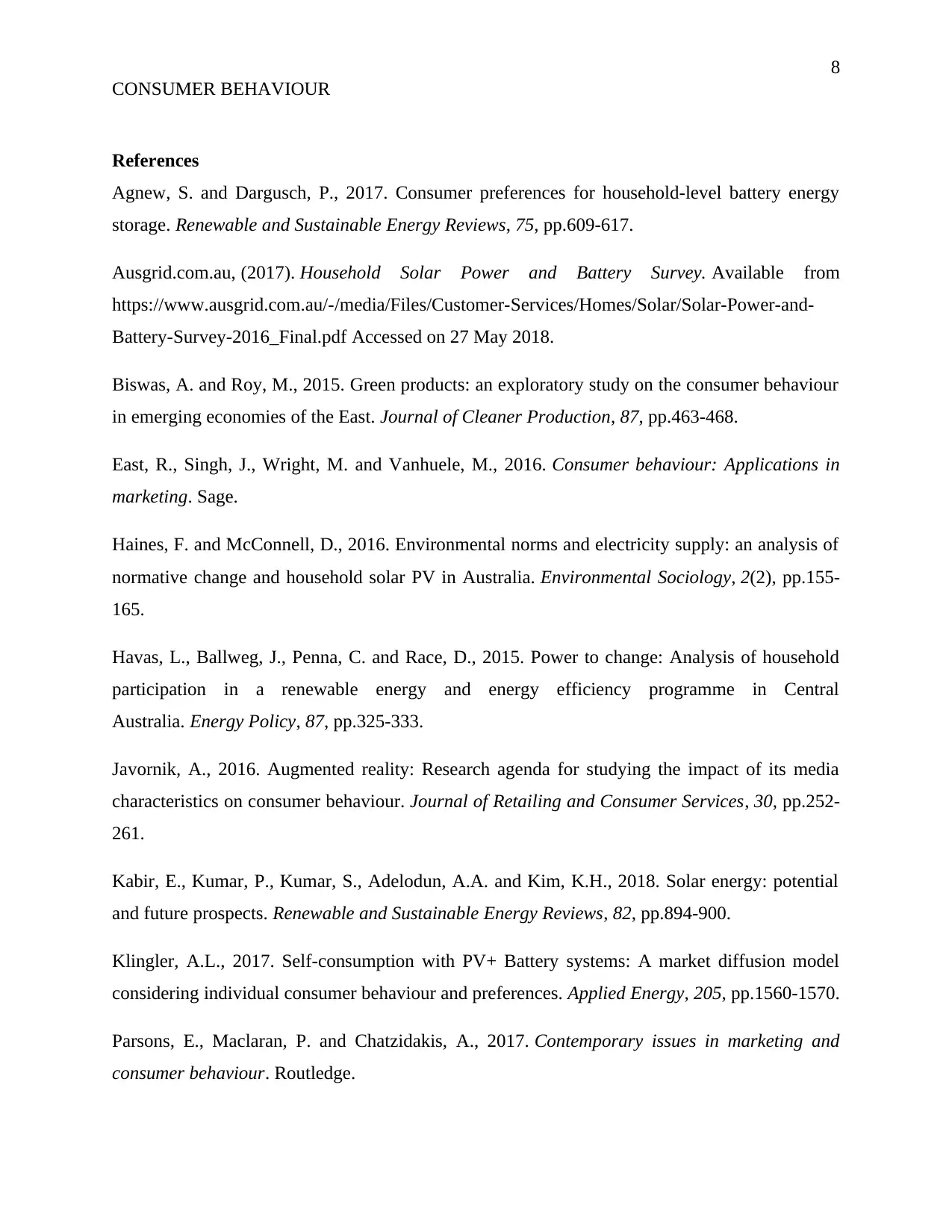
8
CONSUMER BEHAVIOUR
References
Agnew, S. and Dargusch, P., 2017. Consumer preferences for household-level battery energy
storage. Renewable and Sustainable Energy Reviews, 75, pp.609-617.
Ausgrid.com.au, (2017). Household Solar Power and Battery Survey. Available from
https://www.ausgrid.com.au/-/media/Files/Customer-Services/Homes/Solar/Solar-Power-and-
Battery-Survey-2016_Final.pdf Accessed on 27 May 2018.
Biswas, A. and Roy, M., 2015. Green products: an exploratory study on the consumer behaviour
in emerging economies of the East. Journal of Cleaner Production, 87, pp.463-468.
East, R., Singh, J., Wright, M. and Vanhuele, M., 2016. Consumer behaviour: Applications in
marketing. Sage.
Haines, F. and McConnell, D., 2016. Environmental norms and electricity supply: an analysis of
normative change and household solar PV in Australia. Environmental Sociology, 2(2), pp.155-
165.
Havas, L., Ballweg, J., Penna, C. and Race, D., 2015. Power to change: Analysis of household
participation in a renewable energy and energy efficiency programme in Central
Australia. Energy Policy, 87, pp.325-333.
Javornik, A., 2016. Augmented reality: Research agenda for studying the impact of its media
characteristics on consumer behaviour. Journal of Retailing and Consumer Services, 30, pp.252-
261.
Kabir, E., Kumar, P., Kumar, S., Adelodun, A.A. and Kim, K.H., 2018. Solar energy: potential
and future prospects. Renewable and Sustainable Energy Reviews, 82, pp.894-900.
Klingler, A.L., 2017. Self-consumption with PV+ Battery systems: A market diffusion model
considering individual consumer behaviour and preferences. Applied Energy, 205, pp.1560-1570.
Parsons, E., Maclaran, P. and Chatzidakis, A., 2017. Contemporary issues in marketing and
consumer behaviour. Routledge.
CONSUMER BEHAVIOUR
References
Agnew, S. and Dargusch, P., 2017. Consumer preferences for household-level battery energy
storage. Renewable and Sustainable Energy Reviews, 75, pp.609-617.
Ausgrid.com.au, (2017). Household Solar Power and Battery Survey. Available from
https://www.ausgrid.com.au/-/media/Files/Customer-Services/Homes/Solar/Solar-Power-and-
Battery-Survey-2016_Final.pdf Accessed on 27 May 2018.
Biswas, A. and Roy, M., 2015. Green products: an exploratory study on the consumer behaviour
in emerging economies of the East. Journal of Cleaner Production, 87, pp.463-468.
East, R., Singh, J., Wright, M. and Vanhuele, M., 2016. Consumer behaviour: Applications in
marketing. Sage.
Haines, F. and McConnell, D., 2016. Environmental norms and electricity supply: an analysis of
normative change and household solar PV in Australia. Environmental Sociology, 2(2), pp.155-
165.
Havas, L., Ballweg, J., Penna, C. and Race, D., 2015. Power to change: Analysis of household
participation in a renewable energy and energy efficiency programme in Central
Australia. Energy Policy, 87, pp.325-333.
Javornik, A., 2016. Augmented reality: Research agenda for studying the impact of its media
characteristics on consumer behaviour. Journal of Retailing and Consumer Services, 30, pp.252-
261.
Kabir, E., Kumar, P., Kumar, S., Adelodun, A.A. and Kim, K.H., 2018. Solar energy: potential
and future prospects. Renewable and Sustainable Energy Reviews, 82, pp.894-900.
Klingler, A.L., 2017. Self-consumption with PV+ Battery systems: A market diffusion model
considering individual consumer behaviour and preferences. Applied Energy, 205, pp.1560-1570.
Parsons, E., Maclaran, P. and Chatzidakis, A., 2017. Contemporary issues in marketing and
consumer behaviour. Routledge.
⊘ This is a preview!⊘
Do you want full access?
Subscribe today to unlock all pages.

Trusted by 1+ million students worldwide
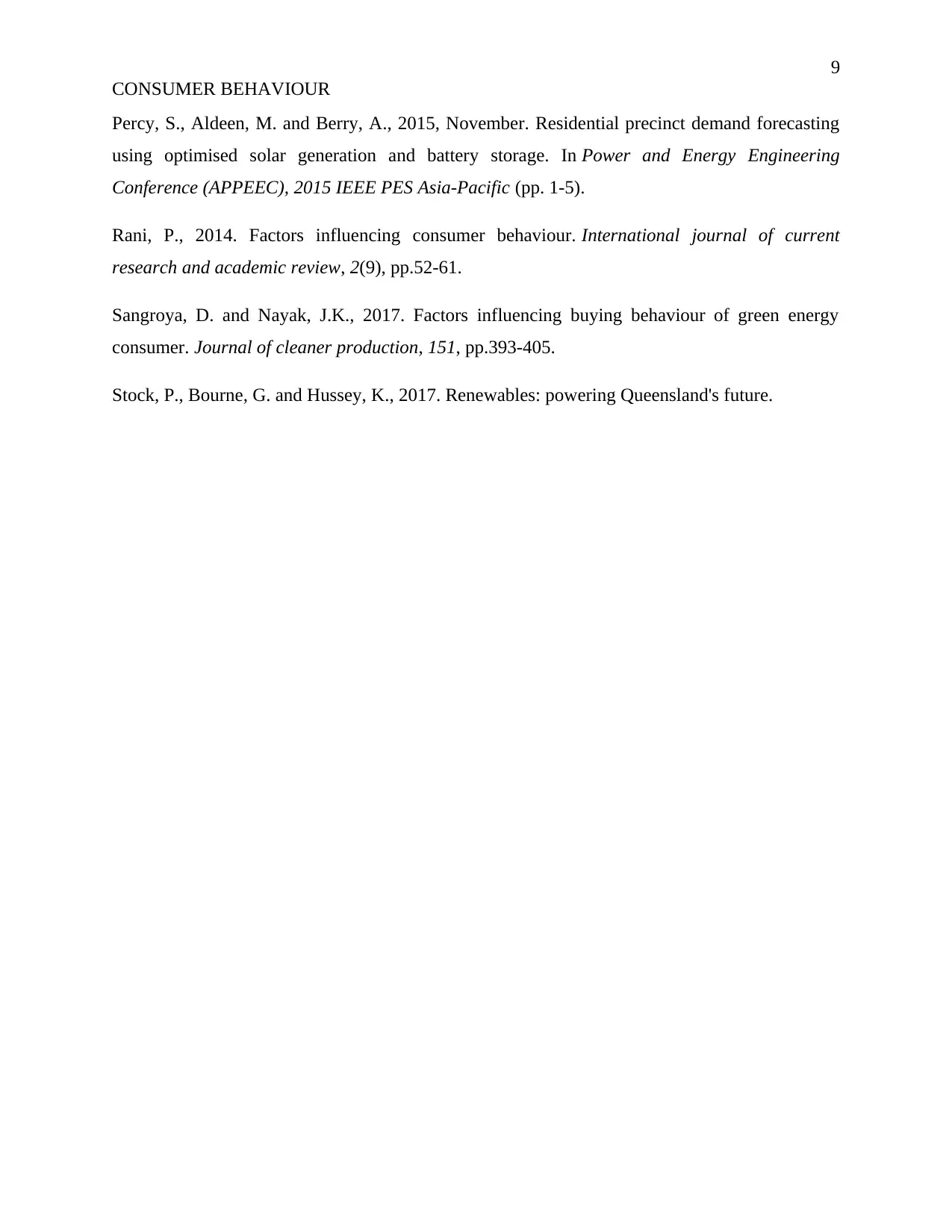
9
CONSUMER BEHAVIOUR
Percy, S., Aldeen, M. and Berry, A., 2015, November. Residential precinct demand forecasting
using optimised solar generation and battery storage. In Power and Energy Engineering
Conference (APPEEC), 2015 IEEE PES Asia-Pacific (pp. 1-5).
Rani, P., 2014. Factors influencing consumer behaviour. International journal of current
research and academic review, 2(9), pp.52-61.
Sangroya, D. and Nayak, J.K., 2017. Factors influencing buying behaviour of green energy
consumer. Journal of cleaner production, 151, pp.393-405.
Stock, P., Bourne, G. and Hussey, K., 2017. Renewables: powering Queensland's future.
CONSUMER BEHAVIOUR
Percy, S., Aldeen, M. and Berry, A., 2015, November. Residential precinct demand forecasting
using optimised solar generation and battery storage. In Power and Energy Engineering
Conference (APPEEC), 2015 IEEE PES Asia-Pacific (pp. 1-5).
Rani, P., 2014. Factors influencing consumer behaviour. International journal of current
research and academic review, 2(9), pp.52-61.
Sangroya, D. and Nayak, J.K., 2017. Factors influencing buying behaviour of green energy
consumer. Journal of cleaner production, 151, pp.393-405.
Stock, P., Bourne, G. and Hussey, K., 2017. Renewables: powering Queensland's future.
1 out of 10
Related Documents
Your All-in-One AI-Powered Toolkit for Academic Success.
+13062052269
info@desklib.com
Available 24*7 on WhatsApp / Email
![[object Object]](/_next/static/media/star-bottom.7253800d.svg)
Unlock your academic potential
Copyright © 2020–2025 A2Z Services. All Rights Reserved. Developed and managed by ZUCOL.





